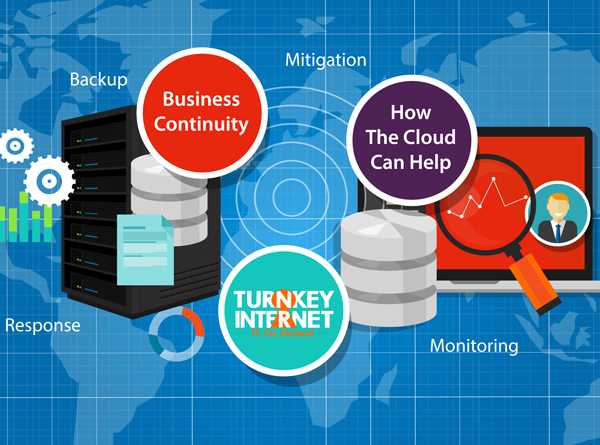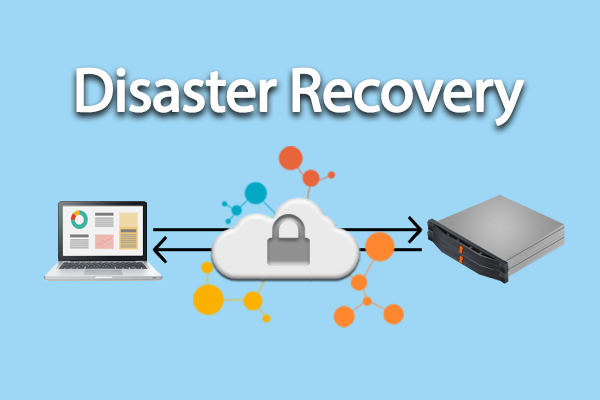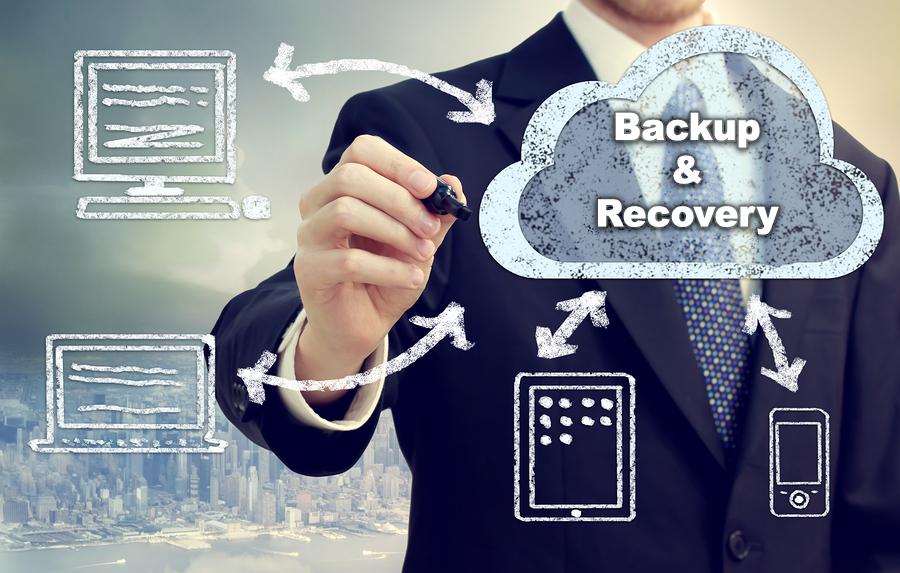Archive for the ‘disaster recovery’ Category
Disaster Recovery – How to Survive When Ransomware Strikes (Infographic) no comments
DON’T GAMBLE – Be prepared when IT disasters strike
Receive a FREE consultation of your company’s Disaster Recovery Plan, visit www.TurnKeyInternet.net/myplan
Follow Us :
Share :
Disaster Recovery: Utilizing Offsite Backups no comments

When it comes to protecting your business or organization’s data, you might feel as though an onsite or in-office backup solution is enough, but it’s not. If all of your files are stored on the same server or in the same physical location, you will still lose everything if that server or office encounters some form of a disaster (weather, malware, human-error, etc.). The good news is that you can combat this problem by utilizing an offsite backup solution.
Utilizing The Cloud
This option involves uploading your data off-site to ‘The Cloud’ – a cluster of servers located in a remote, secure data center. If something happens to your main or onsite backup solution, cloud backups enable you to still have access to the files that you need. Best of all, your data will be available anytime, anywhere, and from nearly any device.
Scheduling
After learning about the importance of offsite backups, many businesses utilize a dedicated server or colocation solution to store their data. Once you determine what data you’ll be backing up offsite, the next step should be to set a schedule. Some people backup their files one time each week, but others do so every night. The number of backups that you want to create will depend on several factors, but the important part is to remain consistent.
Storage Space & Prioritizing
Once you have a backup schedule in place, you want to decide on the amount of time that you will store your data. Many businesses will delete some backups every few months or years, but you might need to keep some records for as long as you can. For example, tax records should be saved for seven years if you don’t want to encounter problems.
Although deciding which files to keep is not always an easy task, prioritizing your data can help. The length of time that you will keep each backup will also depend on the amount of storage space that is available to you. So if your current solutions are not meeting your needs, then it could be time to consider upgrading.
Security & Encryption
Backing up your data is a smart move, but you also need to protect your files from unauthorized individuals. Criminals try to target servers that have the least amount of protection because they want to access data easily. If you don’t secure your files, then you could become a victim. If you own or manage a business, then you are also putting your customers’ data at risk, which is not acceptable.
One of the best ways to secure your data is to utilize encryption. When you encrypt your data, you scramble the code in a way that makes it all but impossible to read. Even if someone can obtain your files, they will not be able to do anything with them. Only those authorized with the decryption key will be able to actually view your data. Most public cloud backup solutions will encrypt you data by default, however if your company has built it’s own private cloud solution, this may not be the case.
Protecting Your Business
If a business loses its clients’ information, then that business could fail. Even if a company can recover from data loss, the fallout could have a lasting impact on its reputation. If customers don’t think that a business takes steps to keep their digital information safe, then they will find a company that does. Backing up your data offsite, in the cloud could be a choice that saves your business from failure.
TurnKey Internet Backup Solutions
Looking for the easiest way to get started with offsite backups? Look no further than TurnKey Internet. We offer the absolute best Cloud Backup solutions on the market, built from the ground up with business users in mind. From encryption so strong that even we can’t see your data, to the most advanced features on the market – like Live Cloud Replication, bare metal recovery and the ability to restore a server, PC or even an entire office of computers, live, in real-time, into a fully functional, cloud-based virtual environment accessible from anywhere over the Internet.
TurnKey Internet’s next-generation Cloud Backup technology offers true Business Continuity and peace of mind through cloud-based redundancy that allows you to restore anything, anytime, anywhere. For more information, visit www.turnkeyinternet.net
Follow Us :Share :
How Your Business Can Survive a Natural Disaster no comments

Smart business owners know the importance of planning so that they can make projections and understand the direction that their businesses need to take. In addition to traditional business plans, it is vital for companies to plan for disasters in order to protect their businesses. Natural and other disasters can cripple businesses, making it difficult for them to recover. When a disaster happens, it is important that businesses have protected their important data so that they can get back to doing business as soon as possible. Businesses that do not have in-depth Disaster Recovery Plans in place when a major natural disaster happens may not be able to recover from them. Fortunately, the advancement of technology has brought simple-to-implement and disaster-proof data protection to businesses, provided by the Cloud.
Lessons From Nature
Some business owners put off disaster recovery planning, thinking that the likelihood of something happening is minimal. Recent natural events demonstrate the importance of implementing a strong recovery plan, however. Hurricane Harvey flooded Houston with enough water that FEMA has projected it will take years for the city to fully recover. Hurricane Irma carved its own path of destruction through Florida, and Hurricane Maria caused total devastation to Puerto Rico.
While Texas, Florida and Puerto Rico are all in hurricane-prone areas, disasters can strike anywhere. The middle of the country and the South are prone to monster tornados such as the mile-wide tornado that destroyed a third of Joplin, Missouri in 2011, killing 161 people and leveling or gutting thousands of buildings, including one of the city’s two major hospitals. Similarly, the Northeastern states are also not immune from disasters as demonstrated by the ravages of Hurricane Sandy. During the winters, the Northeast and upper Midwest also face risks from crippling blizzards, which can down power lines, cause roof collapses and bring businesses to a grinding halt. The earthquake-prone West faces its own dangers of natural disasters, underscoring the importance to businesses everywhere to plan for the worst that could happen.
A common lesson from all of these disasters is that it is highly important for businesses to have backups of their data and IT infrastructure in the located off-site from their office locations and in the Cloud. Having data and IT infrastructure redundancies in the Cloud can protect a business from falling victim to power outages and other storm-related problems. Cloud technology allows businesses to store their data, servers, even their entire IT infrastructure inside a data center, with the ability to access their data as needed or to recover it quickly if disasters strike. This type of cloud solution is known as Colocation. Another cloud solution that data centers offer for businesses is Disaster Recovery as a Service or DRaaS.
DRaaS
With a DRaaS solution, businesses do not have to maintain and invest in their own remote hardware or servers. DRaaS solutions utilize Cloud Replication, in which a company’s entire IT infrastructure is replicated remotely in the cloud. This allows for a much faster recovery time because business applications can continue running over the cloud instead of waiting for data to be restored.
DRaaS offers a cloud-based solution without substantial outlays of capital. It is more service-oriented with customers paying for their consumed resources rather than paying for physical space. DRaaS is scalable, allowing businesses to expand as they need and to choose the appropriate resources for the sizes of their businesses. This means that the resources that they have available to them through DRaaS can grow with the businesses so that they remain protected at all times.
It is important for business owners to plan for everything, including the possibility that disasters may strike. When business owners have strong disaster recovery and business continuity plans in place, they may restart their businesses much faster than they might otherwise after disasters. By working in the cloud, a business’s data and applications are instantly stored so that a disaster may end up being a minor bump in the road rather than a crippling event.
Don’t gamble with your company’s data, call TurnKey Internet at 518-618-0999 and receive a free consultation of your company’s Disaster Recovery Plan. Learn more at www.TurnKeyInternet.net/myplan
Follow Us :Share :
Business Continuity: How The Cloud Can Help no comments

For many, the cloud is simply where you store your personal files with the ability to access them from anywhere. However, let’s say you wanted to backup your company’s important data and have it stored offsite, especially for your Business Continuity or Disaster Recovery plan. Until rather recently, the main option for backups were to do it all locally or on-premises. The backups were usually stored on a disk or even an additional tape drive. Larger businesses may have had another tier that sent backups off site for archiving.
Research conducted by technology research firm of Gartner Inc, shows that backups in an onsite server room or office only worked about 85% of the time. Remote offices were even worse at 75% of the time. Making matters worse, is that you do not know if you have a bad backup until you attempt to restore it. With the introduction of the cloud, the game has changed. You can now backup fast and secure to a hybrid cloud backup via cloud replication.
The hybrid cloud backup or disk-to-disk-to-cloud, allows you to maintain an initial disk backup, which is still stored in house, but has an additional tier that stores the backup in the cloud. The data can be sent in real time to a cloud based server which allows you to have a full copy of your data instantly. For example, say you have a server at your office that experiences a hardware failure, which results in 100% data loss. Since you have cloud replication enabled in your backup, you can simply download your backup from the cloud or redirect traffic to your cloud server. Since the cloud replicated your data in real time, the cloud backup, will match 100% with your dying server.
This tends to be the best of both worlds as the cloud tier is scalable, easy to manager and guarantees data restores properly. Also, restoring from the cloud is perfect for remote offices that aren’t near the local disk backup. With TurnKey Internet’s on premise cloud infrastructure, your data is available instantly and can be accessed remotely from anywhere in the world via our multiple redundant 100 gigabit fiber connections. This removes the bottleneck of your local internet service provider’s bandwidth availability, and saves potentially hours of business critical time waiting for your systems to be back in working order.
Should a disaster occur in which your infrastructure is no longer available or accessible to be restored, the need to purchase new hardware can be completely eliminated. Utilizing our existing cloud infrastructure you can be back online in minutes, not days. Employees can continue their work from home, remotely accessing images of their old workstations running live in the cloud, ensuring your business does not skip a beat.
This type of business continuity is truly invaluable, industry exclusive, and available 24/7/365. For more information and a FREE Disaster Recovery consultation, go to TurnKeyInternet.net/myplan
Follow Us :Share :
What is Cloud Disaster Recovery? no comments

The cloud has changed the way that many businesses handle disaster recovery and business continuity planning. One of the biggest changes the cloud has brought to the business world is the ability for smaller organizations to use the type of data recovery systems that historically were only available to large organizations.
Now, any business’ disaster recovery plan can include complete data backups that are off-site and redundant. Prior to cloud backup systems, businesses were often limited to storing data backups on-site. If a fire broke out or servers were damaged in some other way, on-site data would be lost. Off-site backups frequently required manually making copies of data and/or moving storage media to a different location before cloud computing streamlined the backup process.
The cloud allows data to be saved automatically, and many businesses are working off of cloud-based systems at all times. Another major benefit of using the cloud for backups is that many other types of data storage have significant failure rates. Tapes, in particular, were used for decades as a method of storing backup data, but it has been found that they have about a 10 percent failure rate. Cloud computing offers redundant file storage, so unlike with tapes or even hard drives that could potentially fail, data saved to the cloud is almost guaranteed to always be available. Systems can be set in place to backup data automatically, and cloud storage allows you to keep multiple copies of records with different time-stamps.
Another Disaster Recovery solution the cloud provides is Cloud Replication, which allows for the restoration of data to a virtualized server. Utilizing an off-site data center’s cloud infrastructure, data can be made available instantly, then accessed remotely from anywhere in the world over multiple, redundant, high speed networks. This removes the bottleneck of local internet service providers bandwidth availability, and saves potentially hours of business critical time by bypassing the need to wait for your onsite systems to restore and be back in working order.
Should a disaster occur in which your infrastructure is no longer available or accessible to be restored, the need to purchase new hardware can be completely eliminated. Utilizing a Cloud Replication solution can have your business back online in minutes, not days. Employees can continue their work from home, remotely accessing images of their old workstations running live in the cloud, ensuring your business does not skip a beat.
The cloud is helping businesses recover their most critical systems and data faster, while also avoiding the expensive infrastructure costs of onsite or in-office data centers. Leveraging a cloud solution is by far one of the best, most cost effective ways to protect your company and ensure business continuity when disaster strikes. Whether it be an office fire, hardware failure, employee error, or malware infection, IT disasters are inevitable. That’s why it is critical that you have a plan in place. Don’t gamble with your company’s data, contact TurnKey Internet today and receive a free consultation of your company’s Disaster Recovery Plan.
Learn more at www.TurnKeyInternet.net/myplan
Follow Us :Share :
Data Center Solutions for Disaster Recovery no comments
Businesses that have the potential to be affected in some way by natural disasters can avoid the complete standstill to their services by preparing and planning out just what they would do if their facility suffered a catastrophic loss. Hurricanes, earthquakes, tornadoes, snow storms, flooding, and fire are some of the most obvious causes of potentially disastrous losses that could halt the operations of a business.
In fact, the property of a business does not even have to have any direct damage for a natural disaster to halt their business. For example, loss of electricity, telephone, or internet connectivity can cause problems with functionality, as those services are paramount. If you understand that any type of disaster could destroy your computing infrastructure – where all of your company records and data are stored, which could quite possibly destroy your business – then you should have a plan in place to alleviate that possibility.
Off-Site Backups
At the very least, any business that uses computing to manage their operations should have an off-site back-up of their most important data and records. This is not a very expensive strategy, it is something that can be entirely automated, and it does not even need to be accessed until you actually need to use it. There are automated back-up systems available from most data centers, which back-up your data as frequently as you desire. The incremental changes made in the time-frame chosen are then sent across the internet through an encrypted protocol, and stored in a managed backup system at the data center. Usually, the client is provided with a secure web interface to access those files as needed. These backups can also be used to restore individual data files that may have become deleted or damaged at any time, and downloaded back to the computers in your office.
Infrastructure as a Service (IaaS)
The next step up from simply backing-up your data for protection from a disaster would be hosting some, to all, of your regular computing infrastructure in a data center. This type of solution is known as Infrastructure as a Service or IaaS. If you hosted your main office server in a data center and accessed your files over the internet from the PCs in your office, you could survive a disaster from a computing standpoint. All of your important data could then be accessed from a temporary, remote location, or even by having your employees work from home until the office is re-established.
Many companies are now hosting their entire computing infrastructure in a data center; everything from virtual PCs to their application servers. These can then be accessed through just about any device that is connected to the internet, such as a PCs and smartphones.
Email and Phone
Communicating with your customer base during and after any disaster is vital in many cases. When your email and telephone systems are cut off, and you and your customers can no longer communicate, this could be extremely damaging to your business. By hosting your email server at a data center, you have access to your email system through almost any device connected to the internet.
Another popular data center service is VOIP-based hosted phone systems. In a VOIP-based system, the PBX system normally nailed to the wall in an office is replaced by a PBX server in a data center. Management and administration of the system is then done though a web interface. All phone communication is channeled through voice over Internet protocol (VOIP). The advantage of this in a disaster is that your phone system is always intact. You can access your administration portal over the Internet and change any settings that may be necessary, such as adding additional extensions for remote users. Staff members can work from remote locations or at home, by accessing the phone system with a softphone on their PC or by having their calls transferred from their extensions to their cell phones.
TurnKey Internet’s Data Center
Data centers are the ideal solution to the issues surrounding disaster recovery. The key reason is that they have multiple redundancies in place to provide 100% up-time guarantees. At TurnKey Internet, we have multiple fiber providers supplying our internet and bandwidth through diverse physical paths into our data center. We have state-of-the-art networking equipment in place to maintain your connections, in case one or some of the fiber connections coming into the facility are disrupted.
Additionally, our power supply is backed-up with both a robust battery back-up supply (UPS) to all servers and equipment, as well as dual on-site diesel generators that can power our data center long-term if necessary. For these reasons and more, anyone considering disaster recovery planning should consider the options available from TurnKey Internet, to insure that their business is not damaged long-term by a catastrophic event that had not been planned for.
To get started, visit https://www.turnkeyinternet.net/myplan for a FREE consultation.
Follow Us :Share :
Reviewing Your Company’s Backup and Recovery Plan no comments
Is your company prepared for a catastrophe that could result in the loss of your data? You’ve most likely taken out insurance to protect yourself against natural disasters, robberies and similar catastrophic events. Your data should be no different. The only difference is that this type of insurance involves backing up your data and IT infrastructure, so that your business remains online and operational, even during one of those catastrophic situations mentioned above or something like a hardware failure or a disastrous infection. Here are some key things to focus on when reviewing your company’s existing plan or during the development of a new one:
What to Back Up
Determining what needs to be backed up should be addressed before you look at how you back it up. Do you want to back up everything that is located on computers at the office? What about data located on laptops or cellphones that are taken to and from home? Is your email or website backed up? Do you want them to be? Do you possess physical forms and documents that you want scanned into electronic form and then backed up in that form so that you are set if something such as a fire or flood destroys the hard copies?
You can back up everything, otherwise known as a full backup. This obviously requires the most storage space as well as the most time. However, it helps ensure that you will be completely back up and running in a timely manner if some disaster causes your primary data source to no longer be accessible.
However, this is not always necessary. In that case, consider an incremental or partial backup. An incremental backup involves the backing up of only files that had been created or changed since the last time your data had been backed up. This tends to be much quicker, but you do need to then ensure that you have access to several incremental backups in order to fully restore your data. It can also be difficult to organize your files or to find a specific one if you are downloading several incremental backups after disaster struck.
A partial backup means that you are only backing up part of your data, presumably the most valuable portion. However, the difference between a partial backup and a complete backup is usually minimal, meaning that, with a few exceptions, you might as well just back up everything.
Focus initially on the most important data, whatever would cause the most damage were the information to become inaccessible. These files should also be backed up more often. Of course, it does take time and money to back up your information, but it is well worth it when you consider the repercussions of losing access to it for a considerable time period or forever.
Local / Onsite Backups
Local or onsite backups involve copying and storing your data on a server or drive that is located on the same premises as your primary data source. The most significant benefit of this plan is that you can always have your secondary data right there. If something happens to your primary computer system, it’s normally easy to start utilizing the backup sources, and you don’t need to have an internet connection to do so. The cost of utilizing this type of data backup is usually relatively low, and the process of backing up your data with this method is normally pretty simple.
However, several significant disadvantages exist as well. A natural disaster such as a flood or hurricane that destroys your office or original data source will often take out your backup data too if it’s being kept onsite. And if somebody breaks in and steals your primary data, doing the same to your secondary data too can be done on the same trip.
Cloud Backup
Those taking advantage of cloud backup options will have their data sent to a remote data center on a regular basis. Probably the most significant benefit of going this route is that multiple copies of your data will can be made to stored on multiple servers located in a variety of places. That way if something disastrous happened to one place or server where your backup data was stored, you could simply access an alternate. Your data is safe at these locations as it is encrypted before being stored, and you have instantly scalable storage capacity. Another benefit is being able to automate the process so that you are not dependent on somebody remembering to back up the data.
An indirect benefit of utilizing a cloud backup method is that those who are authorized to do so can easily access the data, whether they are located across town or even on the other side of the world. This is a great benefit for organizations with multiple locations or remote staff. It’s also generally more cost effective than backing up your data onsite, due to not needing to purchase your own backup equipment. However, make sure that you research and trust the data center provider you are using to back up your data remotely.
Cloud Replication
Cloud Replication allows for the restoration of data to a virtualized server. Utilizing an off-site data center’s cloud infrastructure, data can be made available instantly, then accessed remotely from anywhere in the world over multiple, redundant, high speed networks. This removes the bottleneck of local internet service providers bandwidth availability, and saves potentially hours of business critical time by bypassing the need to wait for your onsite systems to restore and be back in working order.
Should a disaster occur in which your infrastructure is no longer available or accessible to be restored, the need to purchase new hardware can be completely eliminated. Utilizing a Cloud Replication solution can have your business back online in minutes, not days. Employees can continue their work from home, remotely accessing images of their old workstations running live in the cloud, ensuring your business does not skip a beat.
Whether it be an office fire, hardware failure, employee error, or malware infection, IT disasters are inevitable. That’s why it is critical that you have a plan in place. Don’t gamble with your company’s data, call TurnKey Internet at 518-618-0999 and receive a free consultation of your company’s Disaster Recovery Plan. Learn more at www.TurnKeyInternet.net/myplan
Follow Us :
Share :
Ransomware, Careless Employees, and IT Gremlins – Better Have Backups no comments
From buying insurance policies to installing security cameras, you take every possible step to protect your business from disaster. But you power on your computer and are met with a screen that claims to have encrypted all of your files. Unless you pay a fee before the timer expires, the program will delete your files forever. Although each situation will be different, this is what will likely happen when ransomware strikes your business.
If you store your customer data, tax information, contracts or any other important files on your network, your business can suffer. Not only will ransomware lock your files, but it can also destroy your reputation if your customers find out that your servers are not secure. When the future of your business is on the line, you can’t afford to leave yourself exposed to the threat.
Taking preventative steps to minimize the effects ransomware is a lot easier than trying to remove it. Once the ransomware takes over a computer, you won’t be able to recover your files without paying the ransom. To ensure your business is ready for a ransomware attack, you should focus on some key areas:
Employee Education
Criminals and hackers will use a range of tactics to infect a business or organization with their malicious software, including sending an email containing an infected link to one of your employees. The infected email can even be made to appear as if it came from one of your company’s email addresses. The moment your employee clicks on the link, the ransomware will jump into action and hold your files hostage. Also, if a member of your team is infected at home and brings a flash drive to work, you could have a problem on your hands.
Teaching your employees how to stay safe online is one of the top ways to protect your business from such attacks. If you want to avoid taking unneeded risks, prevent your employees from using personal devices on your network. Ensure that each person who works for you knows not to click on links unless they are sure that no danger is present. When someone from your company sends an email, have your team call the person to confirm that the email is legitimate. In addition to showing people how to stay safe when they use your network, consider putting policies in place to add an extra layer of protection.
Cloud Backups
Ransomware can easily spread across your office network, encrypting and possibly deleting all of your company’s files. If you want to do everything that you can to avoid such a disaster, consider getting an off-site dedicated server or cloud backup solution for your business. Doing so will allow you to store copies of your files outside of your infected office network, so that you can recover them after an attack.
One thing to keep in mind when searching for a cloud backup provider is storage limits. If your business has a large amount of data that will need to be backed up into the cloud, consider looking for a provider that offers an unlimited storage option.
Disaster Recovery as a Service (DRaaS)
No matter how prepared, you can never totally eliminate the threat of ransomware. Even if you have taken the step to backup all of you company’s critical files, you can still be left with the daunting task of restoring all that data as well as needing to recover your company’s entire IT infrastructure. This is where Disaster Recovery as a Service or DRaaS comes in.
With a DRaaS solution, you can have a complete backup of your business’s vital IT infrastructure at an off-site datacenter. Entire operating systems, whether it be physical or virtual, databases or individual files and folders can all safely and securely be replicated to a datacenter. Data can then be securely pushed back down to your office location, or it can even be restored into a virtual cloud environment, utilizing Cloud Replication.
Cloud Replication
DRaaS solutions that feature Cloud Replication allow for the restoration of data to a virtualized server. Utilizing an off-site datacenter’s cloud infrastructure, data can be made available instantly, then accessed remotely from anywhere in the world over multiple, redundant, high speed networks. This removes the bottleneck of local internet service providers bandwidth availability, and saves potentially hours of business critical time by bypassing the need to wait for your onsite systems to restore and be back in working order.
Should a disaster occur in which your infrastructure is no longer available or accessible to be restored, the need to purchase new hardware can be completely eliminated. Utilizing a DRaaS solution can have your business back online in minutes, not days. Employees can continue their work from home, remotely accessing images of their old workstations running live in the cloud, ensuring your business does not skip a beat.
Be Prepared When IT Disasters Strike
TurnKey Internet is Upstate New York’s only Tier IV featured Data Center providing 100% Guaranteed Uptime. We offer Colocation, IT Infrastructure, New York to California replication, on-premise 24×7 expert local staff, and the Cloud solutions to help your business succeed.
TurnKey’s DRaaS (Disaster Recovery as a Service) solution offers live Cloud Replication for your on-premise IT infrastructure to our Tier IV featured Data Center in a secure virtualized hybrid environment that is instantly available and securely accessed remotely from anywhere.
Don’t gamble, call TurnKey Internet at 518-618-0999 or visit turnkeyinternet.net/myplan to receive a FREE consultation of your company’s Disaster Recovery Plan.
Follow Us :
Share :
Disaster Recovery Plan: Is Your Business Prepared? 1 comment
Disaster can strike at any time. From earthquakes to tornadoes to hurricanes, there is a wide variety of natural disasters that can take place and cause incredible damage to a business. In addition to natural disasters, businesses may also be harmed by fires, floods or IT issues. It is essential that businesses of all sizes have a comprehensive Disaster Recovery Plan.
Here are some of the issues that a business may face following a disaster and how they can ensure business continuity in the aftermath.
Dealing With Displacement
Many disasters can result in major physical damage to buildings and stores. This means that companies should have both an evacuation plan in place and a plan for dealing with the displacement that generally comes with major damage to a building. It may be days or weeks before a building is suitable for people to work in after a fire or a flood, and employees will still often still need a centralized location to work out of.
Organizations should determine ahead of time if employees will be expected to telecommute, if arrangements will be made to rent other facilities or if staff will be routed to other business locations. Some businesses may want to find a middle-ground where employees meet at certain locations a few times a week but do the majority of their work from home.
Employee Communication Systems
One of the major issues that companies run into, even when not dealing with a disaster, is how to communicate effectively. In many cases when there is a disaster, employees are no longer able to go to their normal workplace or call into a specific office to find out what is going on. Therefore, it’s important that a communication system is set up before a problem arises and one is needed.
There are a variety of ways to tackle communications following a disaster, including having a certain phone number that employees call to find out updates about the business. Alternatively, a mailing list or web page can be set up that allows employees to find out the status of a business and what they are expected to do.
Keep Copies of Physical Records
Although the paperless office has been a dream for decades, few businesses are completely digital. Most companies offer paper invoices, and customer contracts are almost always printed and signed in pen. This means that there is often a large amount of paperwork that should be stored in a computer but is not.
To ensure that physical records will still be accessible after a disaster, businesses should have a system in place for making and keeping copies of paperwork. A scanner can be employed to capture images of paperwork, and there are object character recognition software suites that can turn the scanned images into text. Once paperwork is in a computer system, it can then be uploaded to the cloud.
This brings us to one of, if not the most important component of a successful Disaster Recovery Plan, utilizing the cloud
Take Advantage of The Cloud
Cloud computing has changed the way that many businesses handle disaster recovery and business continuity planning. One of the biggest changes that being able to use a cloud backup has brought to the business world is the ability for smaller organizations to use the type of data recovery systems that historically were only available to large organizations.
Now, any business’ disaster recovery plan can include complete data backups that are off-site and redundant. Prior to cloud backup systems, businesses were often limited to storing data backups on-site. If a fire broke out or servers were damaged in some other way, on-site data would be lost. Off-site backups frequently required manually making copies of data and/or moving storage media to a different location before cloud computing streamlined the backup process.
The cloud now allows data to be saved automatically, and many businesses are working off of cloud-based systems at all times. Another major benefit of using the cloud for backups is that many other types of data storage have significant failure rates. Tapes, in particular, were used for decades as a method of storing backup data, but it has been found that they have about a 10 percent failure rate.
Cloud computing offers redundant file storage, so unlike with tapes or even hard drives that could potentially fail, data saved to the cloud is almost guaranteed to always be available. Systems can be set in place to back up data automatically, and cloud storage allows you to keep multiple copies of records with different time-stamps.
Another major benefit of using these types of backup systems is that they can be used almost anywhere. So long as an employee has access to the Internet, they should be able to log into the cloud and access business files and applications.
The Cloud is helping businesses recover their most critical systems and data faster, while also avoiding the expensive infrastructure costs of onsite or in-office datacenters. Leveraging the cloud is by far one of the best, most cost effective ways to protect your company and ensure business continuity when disaster strikes.
Follow Us :
Share :
Cloud Tip of the Month – October 2013 no comments
Why move to The Cloud? Here is October’s  cloud tip!
cloud tip!
Downtime and Load Balancing Problems Diminish Immensely
With the help of cloud-managed services along with services like colocation, your businesses IT downtime problems can be spun 180 degrees! Cloud-managed services and colocation allows for practically 100% uptime with on-site technicians, backup generators, and upscale, reliable servers.
Moreover, load balancing is taken care of. With our always top-of-the-line servers and the capacity of our state-of-the-art data center, we allow for the capability of storing unlimited data from the existing, as well establishing clients, while re-balancing and scaling their servers in real time.
Do not wait for a human error or a storm to knock down your entire IT infrastructure. Business is 24/7! See how moving to the cloud can improve your business, or learn more about the benefits of colocation.
Want to know more about how you can achieve 100% uptime? Visit our site at www.turnkeyinternet.net or contact our sales team at sales@turnkeyinternet.net
Follow Us :Share :








